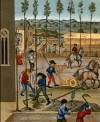The
Middle Ages (500-1500)
 Unlike
in the Classical Period where the human being lay
on the bases of their civilization, in the Middle Ages God and the church formed
the central element of the society. This fact is very important in relation to
the Middle Ages.
Unlike
in the Classical Period where the human being lay
on the bases of their civilization, in the Middle Ages God and the church formed
the central element of the society. This fact is very important in relation to
the Middle Ages.
The Middle Ages began around 500 after Christ. In Europe this was a period of chaos due to the continuous invasions of the barbarian people as well as the migrations that were the direct result of these invasions. During this dark period a lot of the civilization and culture from the Classical Period perished.
The economy of the Middle Ages
was based on agriculture and the feudal system. The people were confused, scared
and scattered. Therefor  they
were barely able to develop themselves on a spiritual level. The people had no
information regarding natural phenomena or diseases and health. They believed
everything was in Gods hands. This primitive civilization, where God was
all-power, saw every form of adversity, every disease, every fight, every failed
harvest, etc. as direct punishment of God. The difference between wealth and
poverty was also explained as Gods will. Therefore everybody reconciled which
meant working very hard to maintain themselves and especially the nobility and
the church.
they
were barely able to develop themselves on a spiritual level. The people had no
information regarding natural phenomena or diseases and health. They believed
everything was in Gods hands. This primitive civilization, where God was
all-power, saw every form of adversity, every disease, every fight, every failed
harvest, etc. as direct punishment of God. The difference between wealth and
poverty was also explained as Gods will. Therefore everybody reconciled which
meant working very hard to maintain themselves and especially the nobility and
the church.
 The
churches and monasteries of course stimulated this idea and emphasized
the idea that man had to live a good life on earth to achieve a place in heaven.
In the Middle Ages the existence on earth was of inferior importance and common
life was aimed at the after life. The fear of the people to end up in hell was
so great that it made them very obsequious to their dictators.
The
churches and monasteries of course stimulated this idea and emphasized
the idea that man had to live a good life on earth to achieve a place in heaven.
In the Middle Ages the existence on earth was of inferior importance and common
life was aimed at the after life. The fear of the people to end up in hell was
so great that it made them very obsequious to their dictators.
The idea of the destruction of
the world exited strongly during the early Middle Ages. This believe intensified
their fear and brought about a big increase of devotion.  In
a Vision of John the Baptist, the Apocalypse, a second arrival on earth of
Christ is foreseen. This arrival will mean the end of the world and all people
will be judged: the Final Judgment. During this final judgment the souls of the
people will be weighted. The good will go to heaven and the bad will be banished
to hell. In the Middle Ages the people were convinced of the fact that this
event would take place exactly 1000 years after the birth of Christ. This year
divides the Middle Ages in the Early (500 a.C. - 1000 a.C.) and the Late Middle
Ages (1000 a.C. - 1500 a.C.).
In
a Vision of John the Baptist, the Apocalypse, a second arrival on earth of
Christ is foreseen. This arrival will mean the end of the world and all people
will be judged: the Final Judgment. During this final judgment the souls of the
people will be weighted. The good will go to heaven and the bad will be banished
to hell. In the Middle Ages the people were convinced of the fact that this
event would take place exactly 1000 years after the birth of Christ. This year
divides the Middle Ages in the Early (500 a.C. - 1000 a.C.) and the Late Middle
Ages (1000 a.C. - 1500 a.C.).
The influence on Art
The church was the place were
the people could not only hear the word of God but they could also see the word
of God. The main purpose of the decoration in the churches was to show and learn
the people the Christian doctrine.
The greater part of the people could neither read nor write. Therefore the
warnings regarding the result of a bad and evil life on earth were reflected
above the entrance and in the interior of the church in a striking way. Often a
scene of the Last Judgment can be found above the main entrance, the
west-portal. This scene reminded the people of what awaited them and stimulated
them to live a good and descent life. In many other places of the Romaine
(Early Middle Ages) churches the horrifying scenes regarding hell and damnation
can be found, which of course had the same effect on the people.
doctrine.
The greater part of the people could neither read nor write. Therefore the
warnings regarding the result of a bad and evil life on earth were reflected
above the entrance and in the interior of the church in a striking way. Often a
scene of the Last Judgment can be found above the main entrance, the
west-portal. This scene reminded the people of what awaited them and stimulated
them to live a good and descent life. In many other places of the Romaine
(Early Middle Ages) churches the horrifying scenes regarding hell and damnation
can be found, which of course had the same effect on the people.
¡@